PRINCETON, NJ -- At a time when President Obama is asking Congress to develop and pass far-reaching healthcare reform legislation, a record-low 45% of Americans say they have a great deal or fair amount of trust in the legislative branch of government, far fewer than trust the judicial (76%) or executive (61%) branches. Second only to the judicial branch are Americans themselves -- 73% trust "the American people as a whole" to make judgments about the issues facing the country.
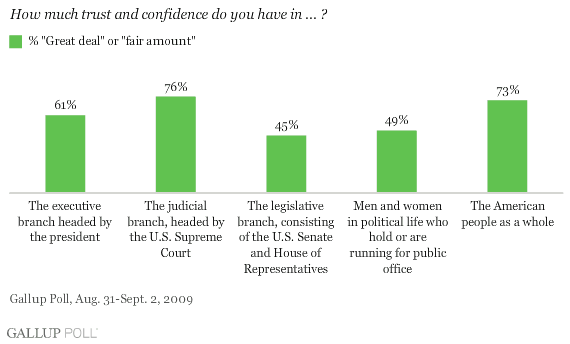
"The data make it clear that the president faces a situation in which the American people trust his branch of government significantly more than the branch to which he has essentially delegated the nuts and bolts of developing a new healthcare plan."
These results, from Gallup's Aug. 31-Sept. 2 Governance survey, update trust ratings extending back to the 1970s that Gallup has updated regularly every September since 2001.
The data make it clear that the president faces a situation in which the American people trust his branch of government significantly more than the branch to which he has essentially delegated the nuts and bolts of developing a new healthcare plan. Recognition of this fact was perhaps behind the president's decision to make a personal plea to the American people with his healthcare speech before Congress (and the nation) on Wednesday night.
The trends for trust in the three branches of government reveal that Americans since 1998 have consistently had a higher degree of trust in the judicial branch than in the other two branches.
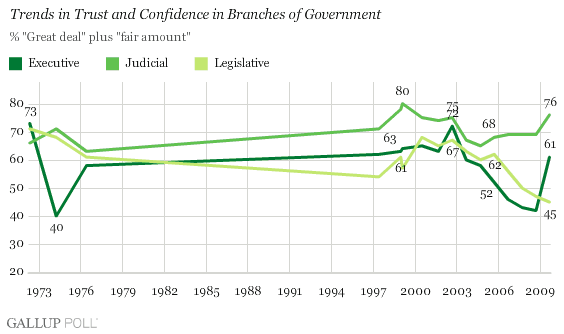
Trust in the executive branch approached an all-time high in 2002, about a year after the 9/11 terrorist attacks and as George W. Bush was still enjoying high job approval ratings. Trust in the legislative branch that year was also relatively high. From that point on, however, trust in both branches began to decrease, and in the latter years of the Bush administration, Americans placed greater trust in the legislative than in the executive branch. This year, coincident with a new presidential administration, trust in the executive branch has jumped, while trust in the legislative branch has continued to decrease, reaching its lowest level in Gallup history.
Trust in the three branches is extraordinarily differentiated by partisan identity.
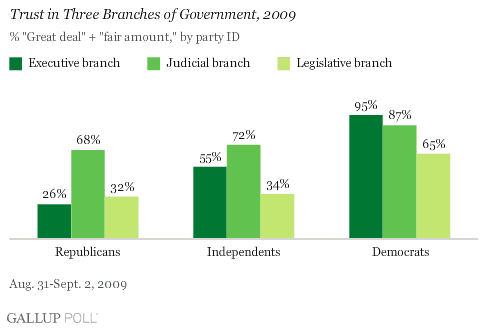
The largest difference in trust levels between Republicans and Democrats, not surprisingly, comes in terms of the executive branch. Almost all Democrats (95%) currently trust the executive branch, compared to just a quarter of Republicans. (Independents are in the middle, at 55%.) There is a smaller gap in terms of trust in the legislative branch; the gap is even smaller for the judicial branch. Still, across the board, Democrats trust all three branches of government most, while Republicans trust all three much less than Democrats do, and two out of three less than independents do.
There has been a diametric shift in trust in the executive branch this year when compared to last year's Gallup update. In September 2008, only 14% of Democrats trusted the executive branch (then headed, of course, by George W. Bush), compared to 83% of Republicans. The judicial branch has seen the same type of shift in trust -- although not nearly as large -- possibly reflecting the recent confirmation of Obama-appointed Justice Sonia Sotomayor to the U.S. Supreme Court.

Differences in partisan trust in the legislative branch are roughly the same this year as they were last year.
Higher Trust in People Than in Politicians
In addition to measuring public confidence in the three formal branches of the federal government, Gallup asks Americans to rate their trust in the primary actors in America's democratic system -- the men and women who hold elected office, and the people who are charged with electing them to office under the United States' democratic system of government.
Trust in the "men and women in political life in this country who either hold or are running for public office" has dropped to an all-time low of 49% this year, after bumping up to 66% in the middle of the 2008 presidential election campaign. At points in the 1970s, about two-thirds of Americans reported having a great deal or fair amount of trust in the men and women in politics, and this had never been below the majority level until now.
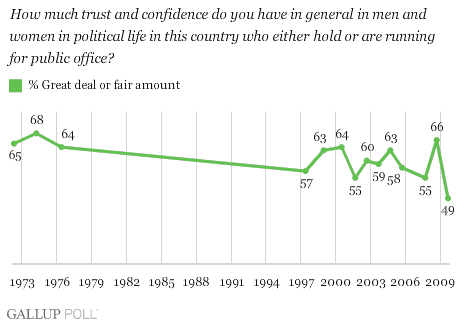
By contrast, there has been a consistently high level of trust in "the American people as a whole when it comes to making judgments under our democratic system about the issues facing our country" over the last several decades, albeit it with a slight downward drift in recent years. The current trust level of 73% is up slightly from a few years ago, but remains below the all-time high of 86% in 1976.
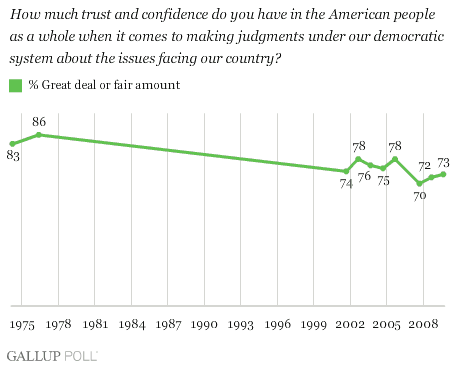
Implications
President Obama has ceded to Congress the specific details of creating new healthcare reform legislation, forging a different path than did President Bill Clinton, who in 1994 presented a plan that had been essentially developed by his administration's healthcare team. Obama's decision comes as Americans are according Congress and the men and women in political office record-low levels of political trust. By contrast, trust in the executive branch has jumped back to levels not seen in six years. This suggests that Obama's decision to take a more prominent position in pushing the healthcare reform legislation, including his speech to Congress on Wednesday night, may have been well-advised.
The current data also underscore the degree to which Americans believe in themselves -- the people of the country. In a democracy, of course, the people have the ultimate power, with the ability to hire and fire the representatives they send to Washington and, through their representatives, to influence the course of legislation the federal government creates.
The noisy town hall meetings on healthcare held across the country this summer may not have been representative of general public opinion, but they did call attention again to the implications of major new policy initiatives coming out of Washington that may not be in sync with the wishes and views of the people. At this point, with trust in Congress at a historically low level, it would appear that elected representatives need to spend more time than ever monitoring the views and opinions of their constituents before passing new policies into law.
Survey Methods
Results are based on telephone interviews with 1,026 national adults, aged 18 and older, conducted Aug. 31-Sept. 2, 2009. For results based on the total sample of national adults, one can say with 95% confidence that the maximum margin of sampling error is ±4 percentage points.
Interviews are conducted with respondents on land-line telephones (for respondents with a land-line telephone) and cellular phones (for respondents who are cell-phone only).
In addition to sampling error, question wording and practical difficulties in conducting surveys can introduce error or bias into the findings of public opinion polls.
